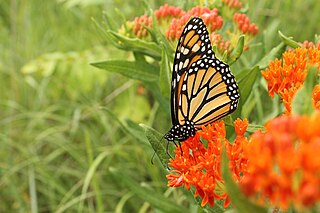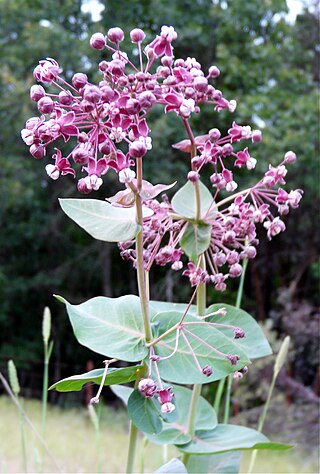
Asclepias tuberosa, commonly known as butterfly weed, is a species of milkweed native to eastern and southwestern North America. It is commonly known as butterfly weed because of the butterflies that are attracted to the plant by its color and its copious production of nectar.

The monarch butterfly or simply monarch is a milkweed butterfly in the family Nymphalidae. Other common names, depending on region, include milkweed, common tiger, wanderer, and black-veined brown. It is among the most familiar of North American butterflies and an iconic pollinator, although it is not an especially effective pollinator of milkweeds. Its wings feature an easily recognizable black, orange, and white pattern, with a wingspan of 8.9–10.2 cm (3.5–4.0 in). A Müllerian mimic, the viceroy butterfly, is similar in color and pattern, but is markedly smaller and has an extra black stripe across each hindwing.

Asclepias is a genus of herbaceous, perennial, flowering plants known as milkweeds, named for their latex, a milky substance containing cardiac glycosides termed cardenolides, exuded where cells are damaged. Most species are toxic to humans and many other species, primarily due to the presence of cardenolides. However, as with many such plants, some species feed upon them or from them. The most notable of them is the monarch butterfly, which uses and requires certain milkweeds as host plants for their larvae.

Calotropis procera is a species of flowering plant in the family Apocynaceae that is native to North Africa, tropical Africa, Western Asia, South Asia and Indochina. It typically grows to a height of 6 feet (1.8 m) to 8 feet (2.4 m) in sunny and partly shaded habitats, including overgrazed pastures, rangeland, roadsides, river flats and coastal dunes. Its green fruits contain a toxic milky sap that is extremely bitter and turns into a gluey coating which is resistant to soap.

Asclepias incarnata, the swamp milkweed, rose milkweed, rose milkflower, swamp silkweed, or white Indian hemp, is a herbaceous perennial plant species native to North America. It grows in damp through wet soils and also is cultivated as a garden plant for its flowers, which attract butterflies and other pollinators with nectar. Like most other milkweeds, it has latex containing toxic chemicals, a characteristic that repels insects and other herbivorous animals.

Butterfly gardening is a way to create, improve, and maintain habitat for lepidopterans including butterflies, skippers, and moths. Butterflies have four distinct life stages—egg, larva, chrysalis, and adult. In order to support and sustain butterfly populations, an ideal butterfly garden contains habitat for each life stage.

Asclepias asperula, commonly called antelope horns milkweed or spider milkweed, is a species of milkweed native to the Southwestern United States and northern Mexico.

Asclepias curassavica, commonly known as tropical milkweed, is a flowering plant species of the milkweed genus, Asclepias. It is native to the American tropics and has a pantropical distribution as an introduced species. Other common names include bloodflower or blood flower, cotton bush, hierba de la cucaracha, Mexican butterfly weed, redhead, scarlet milkweed, and wild ipecacuanha.

Asclepias purpurascens, the purple milkweed, is a herbaceous plant species. It is in the genus Asclepias, making it a type of milkweed. It is native to the Eastern, Southern and Midwestern United States similar to the range of the common milkweed. The plant gets its name from the flowers that first develop a pink color but then turn darker purple as they mature. Unlike common milkweed, purple milkweed prefers some shade and is considered a plant of partial shade. It is also considered an indicator of oak savanna, especially in Wisconsin. The species rarely produces seed pods which are smooth, instead of the rough warty ones produced by common milkweed.

Asclepias fascicularis is a species of milkweed known by the common names narrowleaf milkweed and Mexican whorled milkweed. It is a perennial herb that grows in a variety of habitats.

Asclepias speciosa is a milky-sapped perennial plant in the dogbane family (Apocynaceae), known commonly as the showy milkweed and is found in the western half of North America.

Vincetoxicum nigrum, a species in the family Apocynaceae, also known as black swallow-wort, Louise's swallow-wort, or black dog-strangling vine, is a species of plant that is native to Europe and is found primarily in Italy, France, Portugal, and Spain. It is an invasive plant species in the northeastern United States, parts of the Midwest, southeastern Canada, and California. In 2020, wild plants were found in Timaru, New Zealand.

Asclepias cordifolia is a species of milkweed commonly called heart-leaf milkweed or purple milkweed. It is native to the western United States, growing between 50 and 2,000 m elevation in the northern Sierra Nevada and Cascade ranges. Heart-leaf milkweed was valued by the Native American Miwok tribe for its stems, which they dried and processed into string and rope.

Asclepias meadii is a rare species of milkweed known by the common name Mead's milkweed. It is native to the American Midwest, where it was probably once quite widespread in the tallgrass prairie. Today much of the Midwest has been fragmented and claimed for agriculture, and the remaining prairie habitat is degraded.

Asclepias viridis is a species of milkweed, a plant in the dogbane family known by the common names green milkweed, green antelopehorn and spider milkweed. The Latin word viridis means green. The plant is native to the midwestern, south central and southeastern United States, as well as to the southeastern portion of the western United States.

Asclepias quadrifolia, commonly called four-leaved milkweed or fourleaf milkweed, is a species of milkweed in the Apocynaceae (dogbane) family. It is sometimes referred to as whorled milkweed, but it should not be confused with Asclepias verticillata. A. quadrifolia occurs in the eastern United States and Canada.

Asclepias lanceolata, the fewflower milkweed, is a species of milkweed that is native to the coastal plain of the United States from New Jersey to Florida and Southeast Texas. A. lanceolata is an upright, perennial plant that can grow between 3 and 5 feet tall, with red-orange flowers blooming in the summer months. It can also be referred to as Cedar Hill milkweed, as it was first described by Dr. Eli Ives in the neighborhood of Cedar Hill in New Haven, Connecticut.

Asclepias sullivantii is a species of flowering plant in the milkweed genus, Asclepias. Common names include prairie milkweed, Sullivant's milkweed, and smooth milkweed. It is native to North America, where it occurs in the central United States and Ontario in Canada.

Asclepias angustifolia, commonly called the Arizona milkweed, is an endemic species of milkweed native only to Arizona.

A pollinator garden is a type of garden designed with the intent of growing specific nectar and pollen-producing plants, in a way that attracts pollinating insects known as pollinators. Pollinators aid in the production of one out of every three bites of food consumed by humans, and pollinator gardens are a way to offer support for these species. In order for a garden to be considered a pollinator garden, it should provide various nectar producing flowers, shelter or shelter-providing plants for pollinators, and avoid the use of pesticides.





























